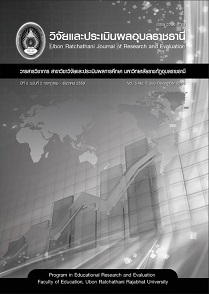Development of Creative Writing Skill Using Synectics Model of The Thai Language for Prathom Suksa 6 Students under the Jurisdiction of Ubon Ratchathani Primary Educational Service Area Office 3
Keywords:
Creative Writing Skill, Synectics Model of TeachingAbstract
The purposes of this research were 1) to develop a creative writing skill using Synectics Model of teaching, 2) compare the results of the development of a creative writing skill before and after using Synectics Model of teaching, and 3) compare the result of the development of creative writing skill between the students taught by using Synectics Model and those taught by a conventional method. The samples were 64 Prathom Suksa 6 students divided into an experimental group and a control group. The research instruments were lesson plans, a behavior observation form, while-learning test, end-of-the-cycle test, and a test assessing writing ability with discrimination power ranging from 0.26 to 0.54. difficulty index ranging from 0.38 to 0.58, and reliability of 0.91. The statistical procedures for data analysis were basic statistics and t-test.
The research findings were as follows:
- The development of creative writing skill using Synectics Model of teaching had three cycles. Cycle 1, before and after the development, the average scores were 15.24 and 34.50 or 37.50%, and 72.50% respectively. Cycle 2, before and after the development, the average scores were 26.44 and 43.56 or 44% and 76% respectively. Cycle 3, before and after the development, the average scores were 15.12 and 24.76 or 46.67% and 80% respectively.
- The students in the experimental group had developed creative writing skill after teaching significantly higher than before teaching at the critical level .01, and they had developed creative writing skill significantly higher than the control group at the critical level .01.
References
กองเทพ เคลือบพนิชกุล. การใช้ภาษาไทย. กรุงเทพฯ: โอเดียนสโตร์, 2542.
กุสุมา หงส์บินมา. ผลการจัดกิจกรรมการเรียนรู้ภาษาไทยแบบซินเนคติกส์ เรื่องการเขียนเชิงสร้างสรรค์
ชั้นประถมศึกษาปีที่ 2. วิทยานิพนธ์การศึกษามหาบัณฑิต มหาวิทยาลัยมหาสารคาม, 2555.
ขจิตพรรณ ประดิษฐพงศ์. การพัฒนาทักษะการเขียนของนักเรียนชั้นประถมศึกษาปีที่ 4 โดยใช้กิจกรรม
ซินเนคติกส์. วิทยานิพนธ์ครุศาสตรมหาบัณฑิต จุฬาลงกรณ์มหาวิทยาลัย, 2535.
ชัยวาฤทธิ์ สร้อยเงิน. การพัฒนาความสามารถการเขียนเชิงสร้างสรรค์ กลุ่มสาระการเรียนรู้ภาษาไทย ของนักเรียนชั้นประถมศึกษาปีที่ 3 โดยใช้กิจกรรมซินเนคติกส์. วิทยานิพนธ์ครุศาสตรมหาบัณฑิต มหาวิทยาลัยราชภัฎธนบุรี, 2553.
ถวัลย์ มาศจรัส. การเขียนเชิงสร้างสรรค์เพื่อพัฒนาอาชีพ ตาม พ.ร.บ. การศึกษาแห่งชาติและหลักสูตรสถานศึกษาขั้นพื้นฐาน. กรุงเทพฯ: เซ็นจูรี่, 2545.
ทิศนา แขมมณี. ศาสตร์การสอน : องค์ความรู้เพื่อจัดกระบวนการเรียนรู้ที่มีประสิทธิภาพ. พิมพ์ครั้งที่ 13. กรุงเทพฯ: สำนักพิมพ์จุฬาลงกรณ์มหาวิทยาลัย, 2553.
ธีรวุฒิ เอกะกุล. การวิจัยปฏิบัติการ (Action Research). พิมพ์ครั้งที่ 3. อุบลราชธานี: ยงสวัสดิ์อินเตอร์กรุ๊ป, 2553.
ปราณี สุรสิทธิ์. การเขียนเชิงสร้างสรรค์เชิงวารสาร. กรุงเทพฯ: โอเดียนสโตร์, 2541.
ยาใจ พงษ์บริบูรณ์. “การวิจัยปฏิบัติการ (Action Research),” วารสารศึกษาศาสตร์มหาวิทยาลัยขอนแก่น. 17, 2 (มิถุนายน – กันยายน 2537) : 11 – 15.
วนิช สุธารัตน์. ความคิดและความคิดสร้างสรรค์. กรุงเทพฯ: สุวีริยสาส์น, 2547.
ศศศร เดชะกุล. การพัฒนาชุดกิจกรรมทัศนศิลป์สร้างสรรค์แบบเทคนิคซินเนคติกส์สำหรับเด็กหญิงระดับชั้นประถมศึกษาของสถานแรกรับเด็กหญิงบ้านธัญญพร. ปริญญานิพนธ์การศึกษามหาบัณฑิต มหาวิทยาลัยศรีนครินทรวิโรฒ, 2553.
ศึกษาธิการ, กระทรวง. หลักสูตรแกนกลางการศึกษาขั้นพื้นฐาน พุทธศักราช 2551. กรุงเทพฯ: โรงพิมพ์คุรุสภาลาดพร้าว, 2551.
สุจริต เพียรชอบ และสายใจ อินทรัมพรรย์. วิธีสอนภาษาไทยระดับมัธยมศึกษา. กรุงเทพฯ: ไทยวัฒนาพานิช,
2533.
Kemmis, Stephen and Robin Mc Taggart. The Action Research Planer. 3rd ed. Victoria: Brown Prior Anderson National Library of Australia Catalouging In Publication Data, 1990.
Kleiner, Charles S. “The Effect of Synectics Training on Students’ Creativity and Achievement in Science,” Dissertation Abstracts International. 2, 3 (July 1991): 368 – A.
Downloads
Published
How to Cite
Issue
Section
License
1. บทความที่ตีพิมพ์ในวารสารนี้ได้มีการตรวจสอบการลอกเลียนงานวรรณกรรมแล้ว ไม่เกินร้อยละ 25
2. บทความที่ตีพิมพ์ในวารสารนี้เป็นข้อคิดเห็น ข้อค้นพบของผู้เขียนบทความ โดยผู้เขียนบทความต้องเป็นผู้รับผิดชอบต่อผลทางกฎหมายใด ๆ ที่อาจเกิดขึ้นจากบทความนั้น ๆ
3. บทความ ข้อมูล เนื้อหา รูปภาพ ฯลฯ ที่ได้รับการตีพิมพ์ในวารสารวิจัยและประเมินผลอุบลราชธานี ถือเป็นลิขสิทธิ์ของวารสารวิจัยและประเมินผลอุบลราชธานี หากบุคคลหรือหน่วยงานใดต้องการนำทั้งหมดไปเผยแพร่ต่อหรือเพื่อกระทำการใดๆ จะต้องได้รับอนุญาตเป็นลายลักษณ์อักษรจากวารสารวิจัยและประเมินผลอุบลราชธานีก่อนเท่านั้น และจะต้องมีการอ้างอิงวารสารวิจัยและประเมินผลอุบลราชธานี ฉบับนั้น ๆ ด้วย






